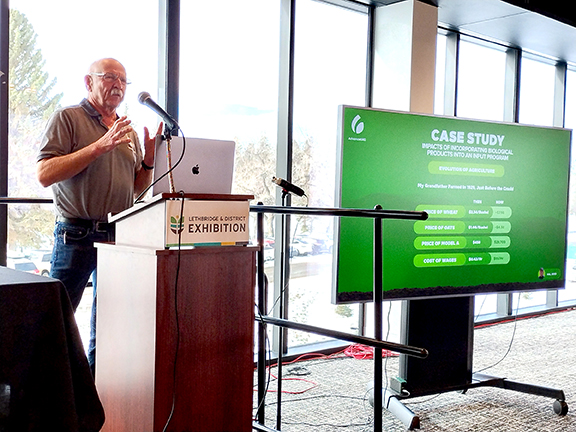Current Temperature
8.2°C
Bio products cutting input for producers: Reed
Posted on March 14, 2024 by Ryan Dahlman Commentator/Courier Photo submitted
CASE STUdy: Hal Reed gives his speech during the 2024 Ag Expo.
Commentator/Courier Photo submitted
CASE STUdy: Hal Reed gives his speech during the 2024 Ag Expo.By Heather Cameron
Southern Alberta Newspapers
Local Journalism Initiative Reporter
During the 2024 Ag Expo in Lehtbidge, there was a program called AdvancedAG – Grow Better with Biology on Feb. 28 where Hal Reed, an agronomist with 40 plus years of experience, spoke about his work with Jeremy Wind, an intergenerational potato farmer who oversees more than 3000 acres. Their work involves using biological products to effectively cut crop inputs and over a 6-year period, they have observed a significant increase in overall crop health, positive changes in soil composition, and tertiary benefits that have made a significant impact to their farming operation.
To start, Reed stated the first commercial fertilizer was created in 1842 by Sir John Bennet Lawes.
“What they did is they treated the phosphates with sulfuric acid creating single super phosphate, and that was the first patented fertilizer,” said Reed.
Then in 1921 in Germany, Reed said, they developed urea on a commercial basis. And, Reed said, with potash, 30 per cent of the world’s needs come from Saskatchewan, as it’s a big potash part of the world.
The interesting part of those numbers, Reed said, is that of all the fertilizer manufactured in Canada, almost 28 per cent of it was used in Canada.
“Why is that?” asked Reed. “What is it that got our fertilizer rates so high over the last few years? Sap testing, I did hundreds of sap samples last year. Sap sampling is the way of measuring the nutrition in a plant. And so, what they do is they take the top leaves – are the newest leaves, and they take the oldest leaves – they compare the nutrition value in both of those things. For example, through the growing season, I want the top and the bottom to be relatively the same. If it’s not, we have a problem. If in my new leaves, I have really high phosphorus levels, and in the bottom leaves I have low phosphorus levels, that plant is cannibalizing itself.”
Reed said that he works a lot with A and L Labs.
“But in their opinion, you’re not going to build soil in one year,” said Reed. “We are trying to build some structure in our soil. We’re trying to move ahead and continue it to build because I can tell you, that we have land down here where over the years our alkali spots are getting bigger, our soil pH is going up, and we must start looking at. ‘How do we start reversing this trend?’”
Reed said that when he started working with Jeremy Wind 25 years ago, the pH of their soil was 7.4, give or take, but now it is at 8.2 and that is a bad thing. The salt numbers, Reed said, are increasing.
“When you have high sodium, you’re not going to get the plant availability,” said Reed. “The sodium is killing the biology. And if you have no biology, there is nothing there to take the nutrient into the plant.”
Reed then mentioned the work that he and Wind are doing with a company called Rainmaker, work that involved starting to treat irrigation water.
“This is what we’re seeing with the roots where there’s high salts, the root hairs are not there,” said Reed. “When you pull up a plant, there’s ugly stuff there, they’re not healthy roots, and a lot of that’s because of the sodium.”
What he’s seen with Advanced Ag is when they get out into Saskatchewan and the dryland, it responds well, but it is not a ‘one and done’ thing; they have to continue to learn, and they have to continue to run trials.
“This is the situation,” said Reed. “We cannot look at the farm overall and say, ‘This is how we’re going to do everything because you have so much variability between farms, it is a tool that we need to manage,’ said Reed. “We’re getting better and better at understanding the challenges.”
Leave a Reply
You must be logged in to post a comment.

